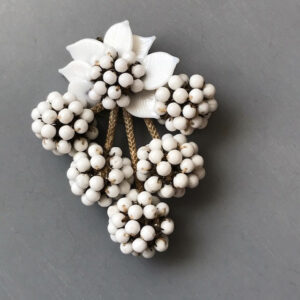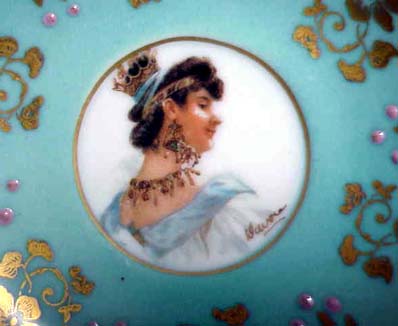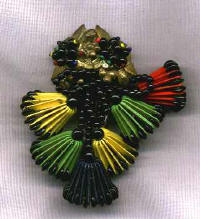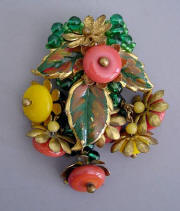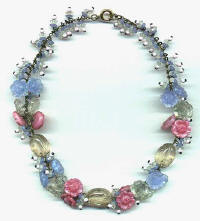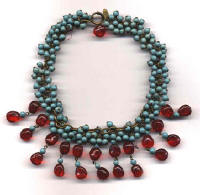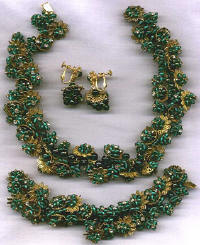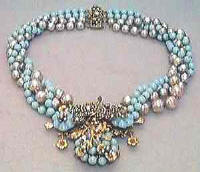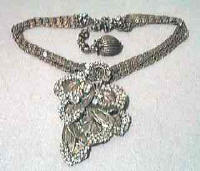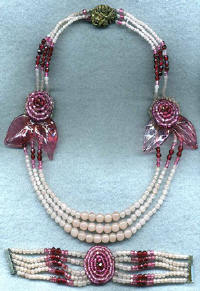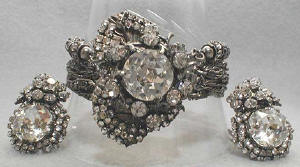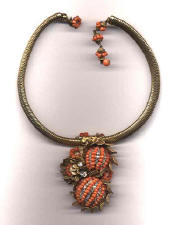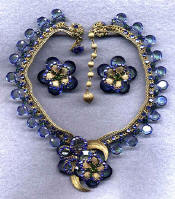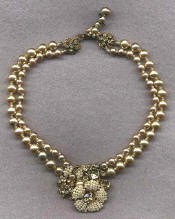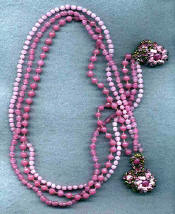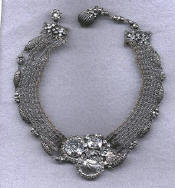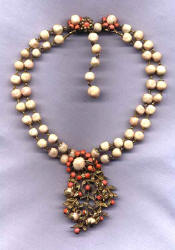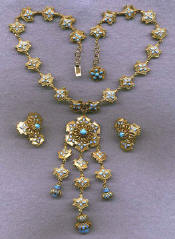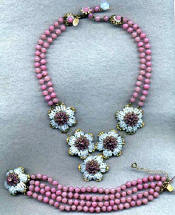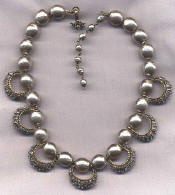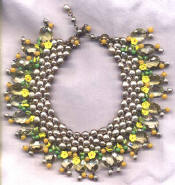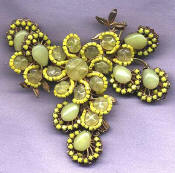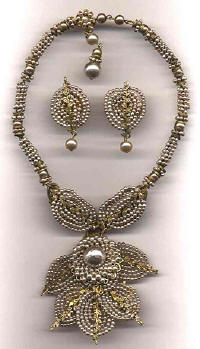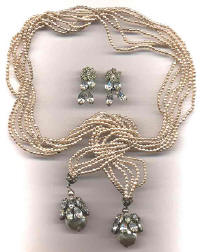|
|
|
Older unsigned Haskell
densely beaded pieces in rich colors…. |
All the jewelry
shown in this article is courtesy of Sheila Pamfiloff, Cathy Gordon and Jane
Clarke. |
Some are pins
and some are clips, but all are magnificent! |
When I first noticed Miriam Haskell
jewelry many years ago, I quickly became aware that I was looking at
jewelry that was quite unique. Unique in the sense that it was involved,
hand made, exquisite in its complex use of glass beads, rhinestones, and
metalwork, and it was immaculate in its execution. The pieces literally
mesmerized me. My great appreciation for the jewelry has not diminished
to this day, but I soon learned that there was more to collecting these
lovely pieces than just scouting around for the name Miriam Haskell.
The difficulty in collecting this
jewelry, then and now, is in acquiring adequate information to be
able to make wise decisions in purchasing. Anyone today can see by a
search through eBay, while viewing countless numbers of signed and
unsigned Haskells, that knowledge is crucial. How would someone know
that the person selling this jewelry is correct in his or her
declaration that this is unsigned, old, or is it even a real Haskell?
This holds true at antique shows as well as antique shops. Is it a
Miriam or isn’t it? Is it old or isn’t it? To quote just a few of the
statements that can be read or heard from sellers, "This is an unsigned
Miriam, because I got it from an estate belonging to an elderly lady who
collected jewelry and they said……..!" Or, "This is an unsigned
Miriam because only Miriam used unusual beads and pearls and filigree."
Or, "I know it’s a Miriam, because I’ve been a dealer for 20 years." My
aim here is to give you a STANDARD for looking at Old Haskells, not the
"exceptions."
For the purposes of this article, I’m
narrowing the discussion from the vast area of designs produced by the
Haskell company to include only those with distinctive Haskell traits. |
The tools to be used in educating yourself are not hard to learn, but they
can be time consuming.
Considering how the values of older Haskells have escalated, the time would
be well spent.
The first tool is
to invest in and read good books. Two exceptional books are "The Jewels of
Miriam Haskell", by Deanna Cera and "Jewels of Fantasy", edited by Ms. Cera.
Additional examples of Miriam Haskell can be found in many Costume jewelry
books written by well respected authorities such as Harrice Miller, author
of "Costume Jewelry: Identification and Price Guide," and other recently
published books. Other examples may be found in vintage magazines and
advertisements. (Sheila was the co-author with Cathy Gordon of a
wonderful book about Miriam Haskell jewelry, written after this article
was).
The second tool is learning to use your
eyes to compare. Always compare! Comparing what you know to be true to the
unknown will help you develop a detective’s eye. For example, collect visual
examples of molded leaves, beads, stampings, filigree parts, findings, and
link chains and then compare these to the piece you would like to identify.
Look at the construction in era-specific pieces that you know, and then
compare this to the prospective purchase.
For the sake of identifying and dating
Haskell pieces, it is easier to impart information if that information is broken
down into smaller specific categories. When I think of the company’s years
of production, in helping with identification, I think in terms of three
broad categories: pre-signature era (1926 to late 1940s), early signature
era (late 1940s through the 1960s), and the later signature era (1970’s to
the present). Then I think of the other more specific categories such as the
designers, findings and metalwork, beads, materials, assemblage, and, very
importantly, styles or colors that were predominant in any given period in
the history of fashion.
There is a warning that I would like to
give when dating Haskell jewelry, however. The theme of tapestry beading on
filigree runs from the late 1940s to the present, coupled with the fact that
the company purchased mass quantities of materials, which they used decade
after decade with some still in use today. This makes accuracy a problem.
However, by keeping in mind these ideas, much can be established in
identifying Haskell jewelry and dating it.
JANE’S NOTE: Sadly there is a lot of Haskell being made to look
like the real thing. Be careful and best of all, buy from a reputable dealer
who knows Haskell well and stands behind what she sells.
|
1926 to the late 1940s ~
the unsigned years
|
Haskell beads
unsigned, but with a variety of color and form. |
Haskell glass
beads, a great example of an unsigned piece to which an insecure dealer
probably
added the hangtag.
|
Another great example of dealer insecurity. This Haskell
parure came with a glued oval on the bracelet and a drilled oval
acting as a hangtag on the necklace. The earrings were made to match.
|
When Miriam Haskell first opened her doors
she had a unique vision as to what her jewelry would be like. Nature would
be used as a reference for these handmade pieces of art. This passion for
nature played out in a multitude of designs using metal and glass for leaves
and flowers, round pearls, colored beads, many with irregular surfaces, and
wonderful little creatures. Her nature theme extended to the use of organic
materials, such as wood, shells, nuts, coral, silk threads, and woven cords.
Her vision was enhanced when she
hired FRANK HESS to be her head designer. Through his career with the
company, asymmetry would be the hallmark of his designs. In thinking of his
tenure as head designer, think detail: The beauty is in the construction.
During the early Hess years these designs
were sometimes playful, and very often complex and luxurious. Era fashions
tended to be sophisticated with high culture and European designers being
the model. Much of the Haskell jewelry was created to enhance the necklines
of these fashion garments, making a statement of crafted art complementing
sophistication.
Hess’s art can be seen in the designs
where beads terminate in tiny little glass beads, prong set rhinestones, or
brass findings. Tiny motifs such as flowers or berries were often placed in
such a way as to cover the entire backing. If there were bead fringes, they
would usually be in uneven lengths. A single bead could very often be
treated as an artwork by surrounding it with smaller accent beads or
rhinestones, enhanced with additional complementary beads and findings in
elaborate treatments.
Before WWII, beads were from France and
Venice and crystals from Bohemia and Gablonz. The connecting wire threading
moved from layer to layer, linking beads, motifs, and metal backings in an
intricately planned process. The first metal backings were mostly hand-cut
perforated metal shapes with fitted solid back plates. At the beginning of
WWII, a variety of stamped pierced-metal backings came into use.
|
|
During the war, clear plastic perforated backings and colored plastic
components were used (see the article on
Unsigned HASKELL). Although European beads were not completely out
of use, they were scarce and locally found materials made their way into
the jewelry, such as natural materials and plastics. Women’s fashion
tended toward the masculine and frugal. Jewelry now accented the
garments with whimsy, novelty, and unusual combinations of new
materials.
There are many many claims about
jewelry being unsigned Haskell. Unsigned Miriam Haskell pieces can be are difficult to identify. Because
of the irregularity of materials, findings and other components, be sure
that you have some examples of documented attributions when confirming
unsigned pieces. Again, comparing the era’s components, construction,
and correct style help greatly. If it looks like 1950s or 1960s, it
probably isn’t unsigned Haskell.
|
|
This Haskell
set is similar to a lariat shown in Cera’s "Jewels of
Haskell". |
A lovely older Haskell
bracelet in the beloved bead-encrusted style.
|
Clear sparkling rhinestones enhance this Haskell
set of bracelet and earrings. |
Late 1940s through the
1960s ~ the early signed years
|
After the War, fashions changed dramatically. Clothing became feminine,
with beautiful necklines and flowing skirts. Evening and casual wear
became important in a woman’s wardrobe. Designers made jewelry to fit
these occasions and many, including Haskell, started signing their work
to take credit for their creations. New styles included high chokers,
multiple strands of beads, large involved bracelets, pearls, and
oriental themes. Some of the color palettes were pastels, aqua blue,
white, black, coral, garnet, citrine, and topaz. Frank Hess was fond of
pale colors in blue, green, pink, and yellow.
In the late 1940s, the famous Haskell
filigrees started being produced by a lengthy gold electroplating
process, resulting in an antique gold finish, which was then lacquered
for protection. These filigree backs came in a variety of shapes and
sizes, often laced together, and were entirely covered by the motifs
created of beads and stones. At this time, the Frank Hess signature look was
introduced, with tapestry beading, and expanded use of pearls and rose montees in wonderfully busy pieces.
Note: Very soon after starting the use of these filigrees, Haskell
started signing their work. Unsigned Haskell with filigree is very, very
rare!
When identifying Haskell of the late
1940s through the 1950s, think of pearls, asymmetry of construction, and
look for perfection. Pay careful attention to the way the pieces are
wired together. Think about the back of the piece. Is it wired carefully
to the front? Is it all hand made? There should never be glued-in pearls
or rhinestones. Pay attention to the spacers. Are they consistent with
Haskell metal or seed bead spacers and are the pearls capped? Are the
marks correct? Hess was an artist and made sure the colors worked
together; if they don’t, be suspicious.
|
Signatures, earring backs, patented findings, and closures are helpful tools
in dating Haskells. However, the subtleties deserve a very lengthy chapter
of their own. In short, the hang tag, horseshoe, incised hook with a tiny
floret attached to its back, applied plaque, and cartouche came into use
within a few short years of each other, each being used according to the
individual design of the jewelry. The general use of the horseshoe mark was
soon discontinued, with occasional later use. The remainder of these marks
and closures are still in use today, with subtle changes over time due to
different manufacturers. Because Haskell bought findings in great quantities
and used them over time, signatures are only one clue in identifying Haskell
and the period of manufacture. A Horseshoe mark could potentially be found
on a very contemporary piece.
When
identifying Haskell, remember that hang tags can easily be removed and
placed on non-Haskell jewelry. Other Haskell signature forms and closures
are also often used on non-Haskell jewelry. Beware of the glued on oval tag,
and the sometimes glued on hang tag. All of these various marks have been
used on non-Haskell jewelry and used with various combinations of Haskell
parts and non-Haskell parts to make re-creations. Look for the other correct
traits and make sure that the construction is consistent when identifying a
Miriam Haskell. In the older Miriam Haskell necklaces, the stringing is
unique. They always used silk thread and backstrung the thread through the
tiny jump ring and back through 3 to 5 beads, for strength.
|
|
This Haskell
set is also in Cera’s book identified as a Clark design, but it does
have the look of a Vrba. |
Pretty in pink, the
Haskell set is an early Clark design. |
Early classically Clark
symmetrical design in faux pearls. |
Robert Clark joined the company in 1958, and in 1960 Frank Hess retired.
Although Clark maintained many of the traditions of Frank Hess in style and
construction, he added his own style preferences and some innovations in
construction. The festoon and bib style necklaces seemed to be a favorite
style for Mr. Clark. Chokers tended to be large, involved and chunky. The
jewelry tended to be symmetrical, with repetition of design carried through
the entire piece, such as in the collarettes and fringes. Pieces made with
mother of pearl or pearlized metals joined the repertoire of materials.
Sometimes a bit of solder was used in joining components. The overall look
of the Robert Clark pieces has a high sophistication and a very elegant
finish.
Robert Clark left Miriam Haskell in 1968
and for a brief period Peter Raines took over as head designer.
|
|
Fabulous Haskell
collar. Cera says 50’s, I think late 50’s, a nice transition piece. |
Haskell
brooch with a wonderful layered effect.
|
A Haskell corsage
of crystals hinged bracelet by Bob Clark circa 1960’s. |
1970s to the present ~ the
late signed years
|
Vrba pink
glass flowers and faux pearls brooch. |
HASKELL Egyptian
scarab motif aqua, blue and orange 2-5/8" brooch designed by Larry Vrba
circa 1972-4. Larry says thousands of these were made because this was
an extremely well-received group which stayed in the line for about 2 years
due to it’s popularity. That is a long time, as many pieces from
that era were only sold for one season.
View #H22991
|
Vrba faux pearl
three flowers brooch. #V18111 |
Larry Vrba joined the Haskell
company in 1968 and became the head designer for the Haskell company in
1970. From the 1970s on, the Miriam Haskell company has continued
to produce their hallmark look, but jewelry fashion had changed
remarkably. Fantasy jewelry had arrived and Hippie power was at its
height. Most of the non-traditional looking Haskell jewelry started
here, including long chains, medallions, exotic themes, woven chains,
simple center drops, and jewelry made with strictly metal components,
just to name a few.
A long thin rectangular necklace clasp, with a 1969 patent number on one
side and Miriam Haskell imprinted on the other, was used from 1975 to
about 1982.
|
|
1990’s designs by head designer Millie Petronzio of HASKELL. Faux seed pearl encrusted,
this BUTTERFLY
brooch is large and the workmanship is without equal. |
HASKELL huge bib made
up of many smaller bows. one of the most beautiful of the later Haskell
necklaces. View
View View
|
HASKELL bangle. View
|
In 1980 Millie Petronzio became the head designer was until about 2010.
Millie loved the traditional pieces and made custom pieces, often in the
style of the old Haskell pieces, provided that the old beads and findings can be
found. A cherished old Miriam can be remade, or a traditional looking
Haskell can be made with a new twist. She was responsible for a wonderful
limited edition Retro Line in 1992 incorporating old designs.
These designers were and are important to
the company in sustaining the old traditions and adding to the new. You
should be familiar with the distinctions in different approaches and
influences brought to the Haskell company during each period.
Armed with some information in methods of
construction, types of materials used at different junctures in the history
of the company, the styles and colors favored in any given era, and knowing
the appropriate marks, you can go far in identifying old Haskell jewelry, with a
possible date approximation. And, much better, you’ll be able to eliminate
the non-Haskell pieces, of which sadly there are many being made now.
Best of all, buy from a dealer who knows and stands behind what she is
selling!
� 2001 Sheila Pamfiloff, All rights
Reserved
All
the jewelry shown in this article is courtesy of Jane Clarke, Sheila Pamfiloff
and Cathy
Gordon.
|
|
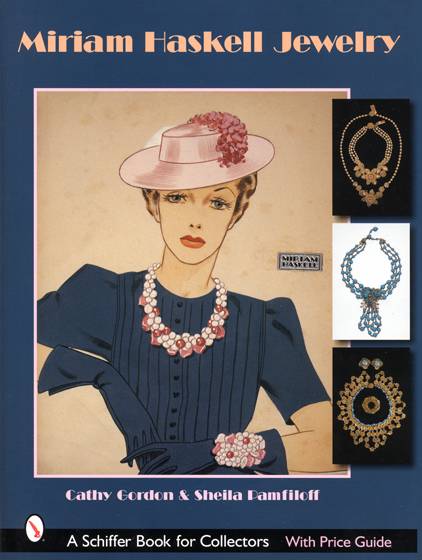 |
BOOK: Miriam Haskell Jewelry
By Sheila Pamfiloff and Cathy Gordon
Schiffer Publications
A comprehensive collector’s guide to
Miriam Haskell Jewelry.
Over 600 Illustrations of delicious collectible pieces, with the
mysteries of identification unveiled.
|
|

